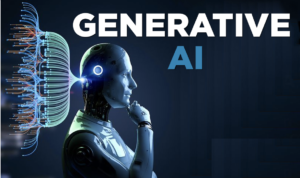
Artificial intelligence has long been transforming industries, and one of its most exciting advancements is Generative AI. This cutting-edge technology can generate new content—ranging from text to images, music, and even code—based on patterns it learns from existing data. Unlike traditional AI systems, which are primarily designed to follow predefined rules or recognize patterns, generative AI creates something entirely new. This shift is revolutionizing various fields, including art, entertainment, marketing, and even healthcare.
In this article, we’ll dive into what generative AI is, how it works, and its real-world applications that are shaping the future.
What is Generative AI?
Generative AI refers to a subset of artificial intelligence focused on producing new content based on learned data. It leverages deep learning models, such as neural networks, to understand patterns from vast datasets. Once trained, these AI models can generate text, visuals, music, and other forms of media that mimic the style and structure of the input data. For example, AI like OpenAI’s GPT-4 can write essays, poems, and technical documentation, while tools like DALL·E can create original images from textual descriptions.
Generative AI is fundamentally different from other AI systems. While traditional AI analyzes data and makes decisions based on existing patterns, generative AI learns these patterns to produce novel content. This ability to “create” has profound implications for industries relying on human creativity and labor.
How Does Generative AI Work?
Generative AI models are based on machine learning techniques, particularly deep learning and transformer models. Here’s a basic breakdown of the process:
- Data Collection: The AI is trained on vast datasets, which could include text, images, or music, depending on the type of content it’s meant to generate.
- Pattern Recognition: Using neural networks, the AI learns the patterns, rules, and structures within this data.
- Content Generation: Once trained, the AI can generate new content based on the learned patterns. It doesn’t just copy the data it was trained on—it creates something entirely new that mirrors the style and structure of the original data.
A famous example is OpenAI’s GPT-4, a generative AI model capable of producing highly coherent and contextually appropriate text. Other notable examples include DALL·E, which can generate images from text descriptions, and MusicLM, an AI model developed by Google that can create music from textual input.
Real-World Applications of Generative AI
Generative AI has quickly moved from research labs to real-world applications. Here are some key industries being transformed by this technology:
1. Content Creation and Marketing
Generative AI is revolutionizing content creation by automating tasks like writing blog posts, generating product descriptions, and even composing email responses. Marketing teams are using AI tools to create personalized ad copy and social media content, drastically reducing the time and effort involved in content production. Companies like Jasper AI are already offering AI-powered content generation platforms for businesses.
2. Art and Design
In the art world, generative AI is pushing the boundaries of creativity. Artists and designers are using AI tools to create original digital artwork, design logos, and even develop architectural models. Platforms like DALL·E have shown how AI can turn textual descriptions into stunning visuals, providing endless creative possibilities.
3. Healthcare
In healthcare, generative AI is being used to generate synthetic medical data to train models without compromising patient privacy. AI models can also help design new drugs by generating novel molecular structures. The potential to revolutionize medical research is immense, with faster drug development and more efficient training for AI-based diagnostic tools.
4. Entertainment and Gaming
Generative AI is making waves in the entertainment and gaming industry by automating character design, plot development, and world-building in video games. AI-generated music and sound effects are also enhancing immersive experiences in films and virtual reality platforms. Companies are exploring how AI can produce endless content, reducing development costs and enhancing creativity.
The Ethical Concerns Surrounding Generative AI
While generative AI offers incredible opportunities, it also raises ethical concerns. One major issue is deepfakes—AI-generated content that mimics real people’s voices or appearances, often for malicious purposes. The ability to generate highly realistic fake media has sparked debates about privacy, misinformation, and intellectual property rights.
Moreover, there’s the question of job displacement. As generative AI becomes more capable, there is a growing concern that creative jobs in writing, design, and entertainment could be threatened. However, proponents argue that AI can augment human creativity rather than replace it, enabling creators to focus on higher-level tasks while AI handles repetitive work.
Conclusion: The Future of Generative AI
Generative AI is rapidly becoming one of the most transformative technologies of our time. From automating creative processes to generating entirely new forms of content, its potential is vast and far-reaching. As with any powerful technology, it comes with ethical challenges that need careful consideration, but its impact on industries like marketing, healthcare, and entertainment is undeniable.
As this technology continues to evolve, it’s clear that generative AI will play a significant role in shaping the future of content creation. To stay updated on the latest advancements, check out this official resource on generative AI.




